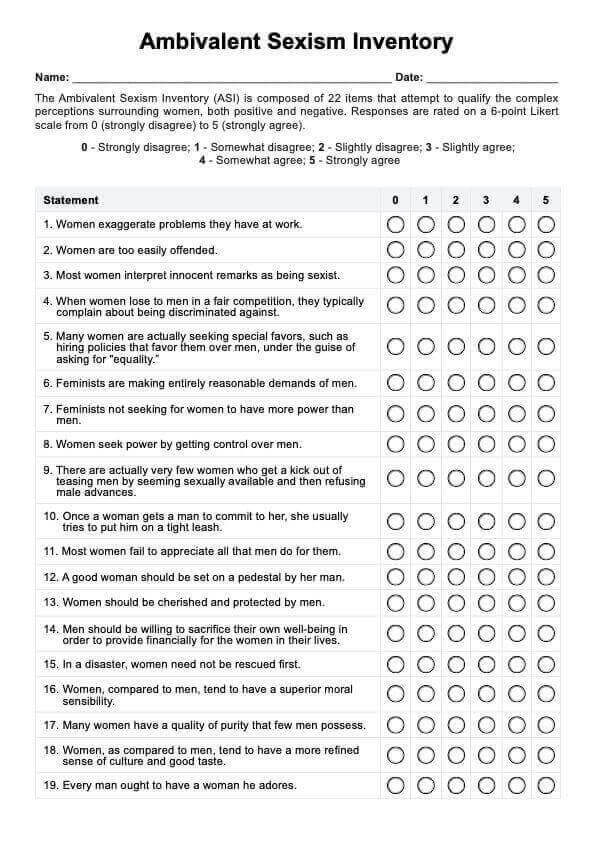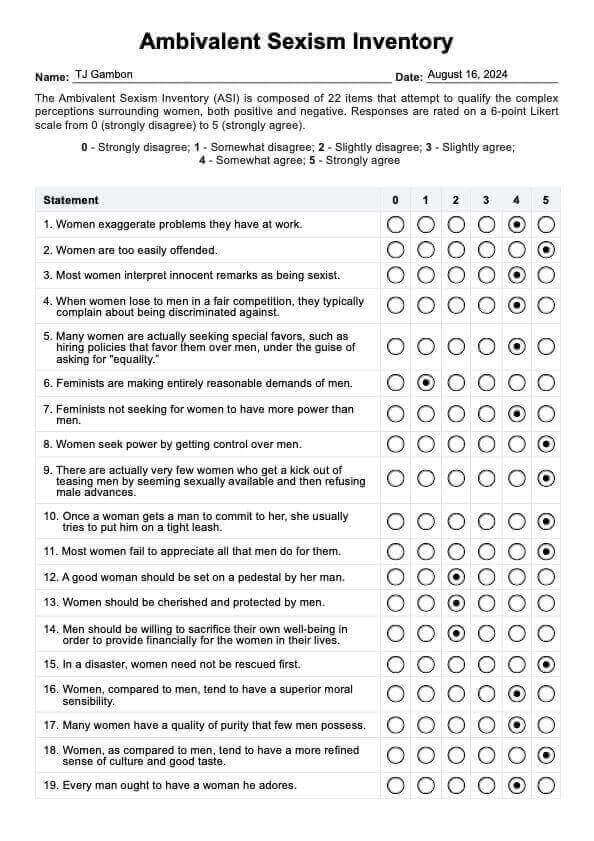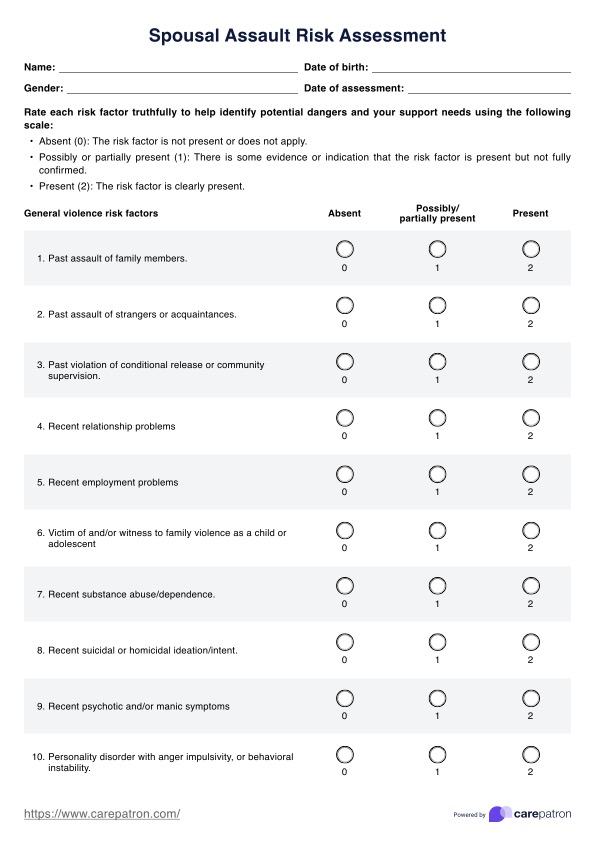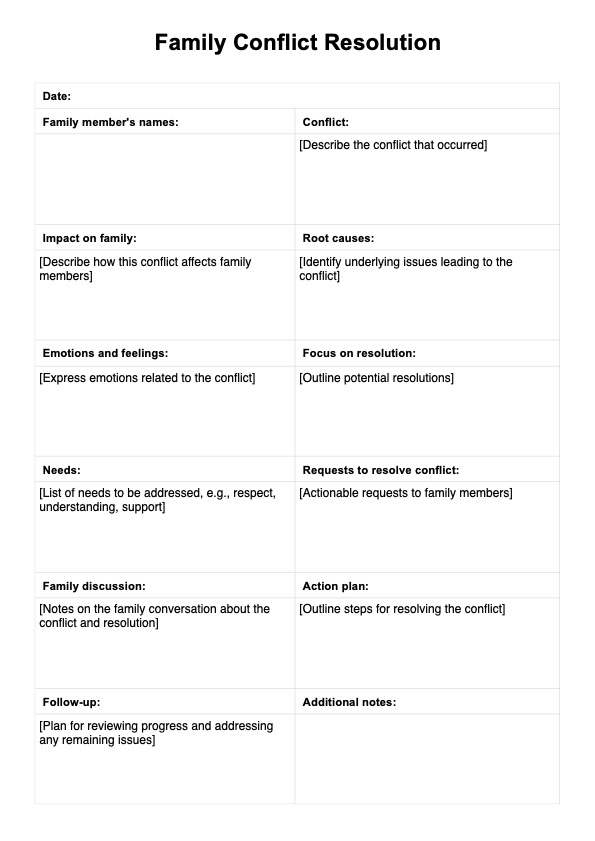Ambivalent Sexism Inventory (ASI)
Explore the Ambivalent Sexism Inventory (ASI) to understand and assess both hostile and benevolent sexist attitudes, crucial for improving gender relations.


What is the Ambivalent Sexism Inventory (ASI)?
The Ambivalent Sexism Inventory (ASI) is a psychological assessment tool developed by Peter Glick and Susan Fiske in 1996. It was created to measure two distinct but related forms of sexism: hostile and benevolent sexism.
Hostile sexism encompasses overtly hostile attitudes and stereotypes about women. One example is viewing women as manipulative, that women seek to gain power or control over men. Another is the belief that women lose to men in a fair competition because they are inferior.
In contrast, benevolent sexism includes seemingly positive but patronizing beliefs that suggest women should be protected, cherished, or placed on a pedestal. These are subjectively positive perceptions in that the men holding these beliefs think that these are good things, even when they are not. These also include acceptance of the gender difference while still making women out to be better.
The ASI’s purpose is to capture the dual nature of sexism for both men and women, recognizing that both hostile and benevolent attitudes can perpetuate gender inequality. The inventory has demonstrated high validity and reliability across diverse populations, with Cronbach's alpha coefficients typically ranging from 0.80 to 0.92 for the overall scale, and 0.70 to 0.92 for the subscales. This strong internal consistency makes the ASI a trusted tool for assessing gender attitudes in both research and clinical settings.
Ambivalent Sexism Inventory (ASI) Template
Ambivalent Sexism Inventory (ASI) Example
How to use our Ambivalent Sexism Inventory template
To effectively use our Ambivalent Sexism Inventory (ASI) template, follow these steps:
Step 1: Access the template
Begin by accessing the Ambivalent Sexism Inventory template. You can do this through the Carepatron app by selecting "Use Template." This will open the template, allowing you to customize it, share it with others, fill it out digitally, or print it for manual use.
Step 2: Explain the inventory to the patient
Before administering the inventory, explain its purpose to the patient. Ensure that they understand the goal of the assessment, which is to evaluate attitudes and beliefs related to gender and sexism. Emphasize the importance of honest and thoughtful responses.
Step 3: Wait for the patient to complete the self-report
Provide the template to the patient and instruct them to complete the self-report. Remind them to respond to each statement truthfully, considering their personal beliefs and attitudes. If needed, you can offer to be available for questions, but allow them to complete the inventory independently.
Step 4: Review and discuss the results
After the patient has completed the inventory, review their responses. Discuss the results with the patient, highlighting any areas of concern or interest. This discussion can lead to further exploration of the patient’s attitudes and how they might affect their behavior and relationships.
Scoring
Scoring the Ambivalent Sexism Inventory (ASI) involves calculating the overall score as well as individual scores for the subscales. Here's how to interpret the results:
- Reverse code specific items: Before calculating subscale scores, reverse the scores for the following items: 6, 7, 9, 15, 20, and 22. For these items, if a patient selected "Strongly agree" (score of 5), it should be treated as "Strongly disagree" (score of 0), and so on.
- Calculate the total score: Add up the responses for all 22 items to get a total score. This represents the individual's overall adherence to sexist beliefs.
- Subscale scores:
- Hostile sexism: Add up the scores for items 1-11. A higher score indicates stronger negative attitudes and stereotypes about women.
- Benevolent sexism: Add up the scores for items 12-22. A higher score indicates more positive but still patronizing beliefs about women, reflecting attitudes such as protective paternalism, complementary gender differentiation, and heterosexual intimacy. These subscales can all have their own scores.
A higher overall score indicates stronger adherence to sexist beliefs. A higher hostile sexism score correlates with more overtly negative attitudes toward women, while a higher benevolent sexism score suggests a more subtle but still harmful form of sexism, where positive attitudes are linked to traditional gender roles, such as protective paternalism and heterosexual intimacy. This can reveal whether an individual leans more toward overtly hostile or seemingly positive but still restrictive beliefs about gender roles.
Now that you have a result, here’s what you can do next.
Next steps after using the ASI
Once you’ve assessed the results of the Ambivalent Sexism Inventory (ASI), there are several important steps to take to ensure the patient or client understands the implications of their scores and receives appropriate guidance.
- Discuss the results with the patient: Review the scores with the patient, helping them understand their overall and subscale scores. Explain what these scores indicate about their attitudes toward gender roles and relationships.
- Provide education on sexism and gender roles: Offer resources or counseling sessions that focus on the impact of sexist beliefs on personal and societal well-being. This can include discussing how these beliefs might influence their behavior, relationships, and even mental health.
- Recommend individual therapy: If the scores indicate a strong adherence to sexist beliefs, suggest individual therapy to explore underlying issues and work on cognitive restructuring. Cognitive-behavioral therapy (CBT) can be particularly effective in challenging and changing these deep-seated beliefs.
- Encourage participation in group therapy or workshops: Group settings can be beneficial for discussing gender roles and stereotypes. Participation in workshops or group therapy can help individuals see different perspectives and foster a more equitable understanding of gender.
- Address potential impacts on relationships: If the patient’s beliefs are causing tension or dysfunction in their relationships, recommend couples therapy or relationship counseling. This can help them work through any conflicts arising from differing views on gender roles and improve communication with their partner.
Continuing to hold onto sexist beliefs can negatively impact various aspects of life, including personal relationships, social interactions, and mental well-being. For women, internalizing sexism can lead to low self-esteem and acceptance of harmful gender norms. For men, adhering to these beliefs may result in hostile sexist attitudes, leading to strained relationships and an inability to connect deeply with others.
Commonly asked questions
Glick and Fiske's Ambivalent Sexism Inventory (ASI), developed in 1996, is a psychological tool used to measure sexist attitudes, dividing them into hostile and benevolent sexism.
The ambivalent sexism theory framework consists of two components: benevolent and hostile sexism. Hostile sexism reflects negative attitudes toward women, while benevolent sexism reflects seemingly positive but patronizing attitudes toward women.
Hostile sexism involves overtly negative beliefs about women, while benevolent sexism involves seemingly positive beliefs that reinforce traditional gender roles and can still be harmful. Benevolent sexism involves protective paternalism, complementary gender differences, and beliefs about heterosexual intimacy.
An example of sexist ambivalent attitudes is when a man believes women should be cherished and protected (benevolent sexism) but also thinks women are too easily offended or overly emotional (hostile sexism).




















-template.jpg)



















































































